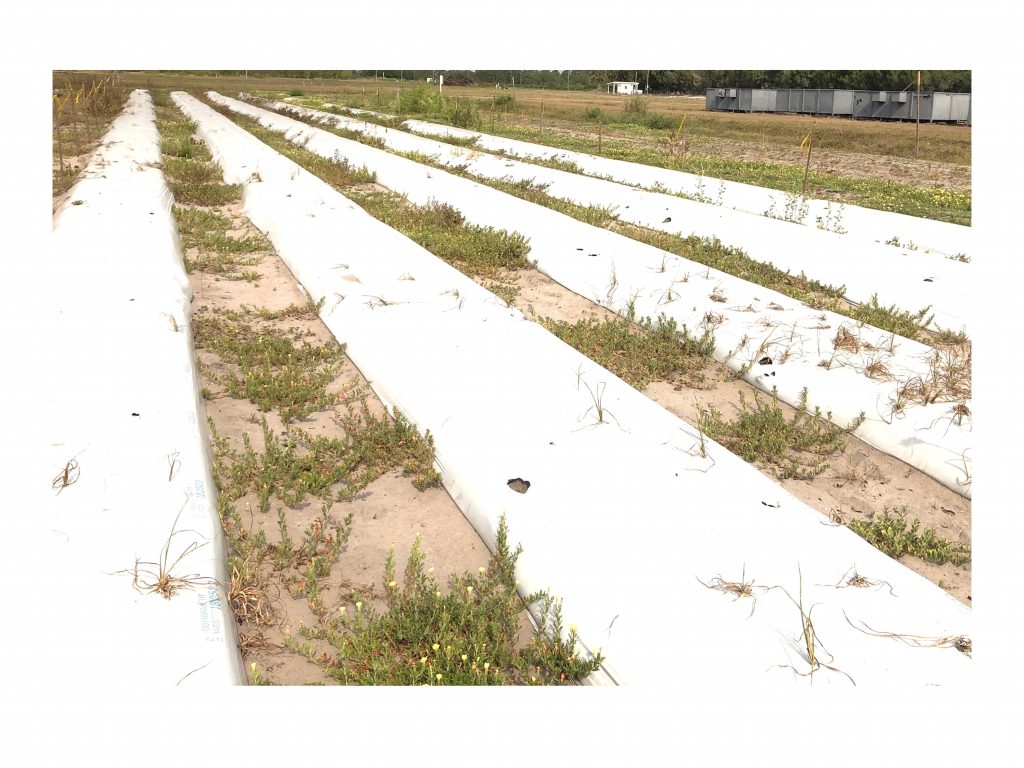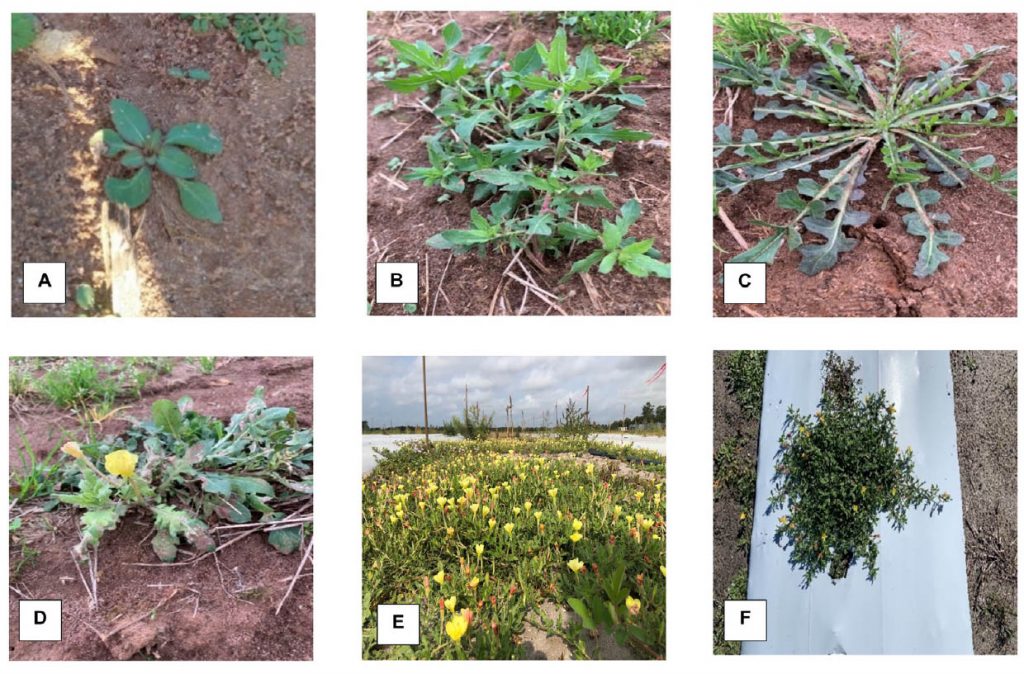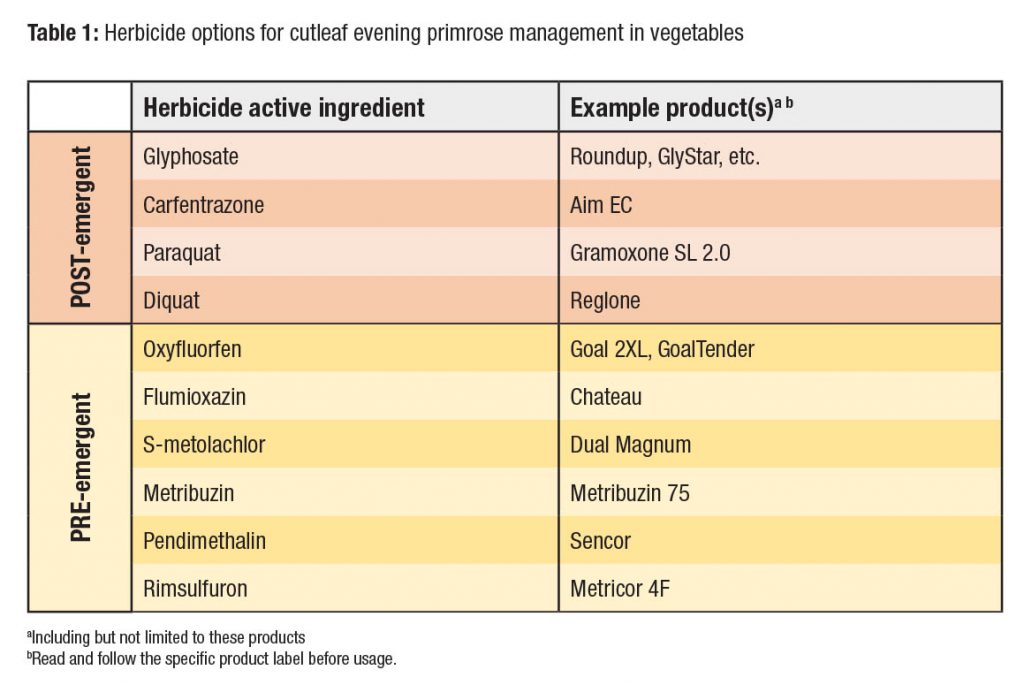
By Ruby Tiwari and Ramdas Kanissery
Cutleaf evening primrose (Oenothera laciniata) is an annual weed (or sometimes a biennial) commonly found throughout vegetable farms in Florida. This weed got its name due to the timing of its flower opening. It tends to close its flowers during the day but opens them during evening or nighttime.
Cutleaf evening primrose is a heavy seed setter. The seeds can remain viable in soil for several decades, creating a seed bank in the soil for future infestation if not managed properly (Figure 1).
OCCURRENCE AND GROWTH STAGES
Cutleaf evening primrose is native to the United States and occurs throughout the southeastern states. The weedtypically emerges in late fall or early spring and completes its life cycle before summer. Every so often, however, this weed takes two years or seasons to complete its life cycle. The plant produces a rosette of leaves the first year. Flowers, fruit and seeds will be formed during the second year of growth.

Newly emerged cutleaf evening primrose has egg-shaped cotyledons. Seedlings are formed as basal rosettes (Figure 2A). Young leaves develop untoothed margins while the matured leaves have toothed margins (Figure 2B and Figure 2C). As the plant matures, the margins of the leaves develop deep tooths (hence the name “cutleaf”).
The upper surfaces of the leaves tend to be hairy. This weed also has hairy stems that are often reddish and can either be simple or branched from the base. Key identifying features of this weed species are the white mid-vein typically found on the leaves and a red-colored base when cut with a knife near the soil.
Individual flowers consist of yellow or yellowish-red, or pink petals fused at their base to form a long narrow tube (Figure 2D and Figure 2E). The fruit is a capsule (~1-inch long) that tapers toward the end. Once the fruit capsule matures, it opens and releases the seeds into the soil. Each plant can produce up to 100 capsules with more than 100 seeds per capsule.
Usually, this weed grows upright and can grow up to a couple of feet tall. Occasionally, however, the stems recline and may show a spreading or creeping growth habit (Figure 2F).
MANAGEMENT CONSIDERATIONS
Cutleaf evening primrose that emerges on raised beds and in the spaces between the raised beds (row middles) can be very competitive with vegetable crops. This weed also can serve as a host for pests and diseases. Moreover, cutleaf evening primrose germinating late in the season in row middles can potentially interfere with harvesting operations. Hence, effective strategies to manage this weed should be in place. This starts with proper sanitation and scouting practices.
Special attention should be given to examining farm perimeter areas, canal banks, etc., as these could be sources for invasion of cutleaf evening primrose onto the farm. Mow or spray the weeds at the edges of fields and the banks of irrigation channels to prevent seed formation. Seeds of cutleaf evening primrose can move with the wind, water, etc. Seeds can cling to farm equipment and get spread throughout the farm. The weed seeds also can move between farms via tractors, sprayers, cultivators, harvest equipment, etc. Therefore, care should be taken to clean equipment after completing an operation on a farm with heavy weed infestation.
CHEMICAL CONTROL
Post-emergent herbicide options for cutleaf evening primrose management include systemic herbicides (e.g., glyphosate) or contact herbicides such as paraquat, carfentrazone and diquat. Attaining adequate spray coverage by selecting an appropriate spray volume (e.g., ≤ 50 gallons per acre) and adding a surfactant (e.g., crop oil concentrate, nonionic surfactant, etc.) as instructed by the herbicide label are crucial for the effective post-emergent control of this weed.
The optimal time for applying post-emergent herbicides to control this broadleaf weed is when it is young and in an actively growing stage. Cutleaf evening primrose becomes much more difficult to control once it matures and produces flowers and seeds. Repeated applications may be required for heavy infestations.

As the seeds of cutleaf evening primrose are exceptionally long-lived and can potentially remain viable in the soil, utilizing a pre-emergent herbicide effectively suppresses its seed germination. Herbicides such as oxyfluorfen, flumioxazin, S-metolachlor, metribuzin, pendimethalin and rimsulfuron provide good pre-emergent control of cutleaf evening primrose. Pre-emergent herbicide application could be made as a part of land preparation, before planting or to the row middles after bedding to prevent cutleaf evening primrose germination.
Pre-emergent herbicides work best when applied to clean ground or when the existing weed stand is low or minimal. When applying pre-emergent herbicides, uniform coverage of the soil surface is important for suppressing weed emergence.
Examples of herbicides utilized for managing cutleaf evening primrose in vegetable production are provided in Table 1.
Ramdas Kanissery is an assistant professor and Ruby Tiwari is a Ph.D. graduate student, both at the University of Florida Institute of Food and Agricultural Sciences Southwest Florida Research and Education Center in Immokalee.









